Jason Schneider
the Camera Collector
The Elemental Argus A of 1936-1941
The modest Art Deco cutie that put 35mm film on the map in the U.S.A.
By Jason Schneider
The humble Bakelite bodied Argus A was not, as some have claimed, the first American made 35mm still camera—it was preceded by the rare Missouri-made Smith of 1912, and the Simplex and Tourist Multiple, both introduced in 1914. However, this spartan Art Deco classic may well be the most important American 35mm camera because it was the first inexpensive U.S.-made 35 and was largely responsible for popularizing the 135 format (24 x 36mm) in the United States at a time when the country was still in the throes of the Great Depression.
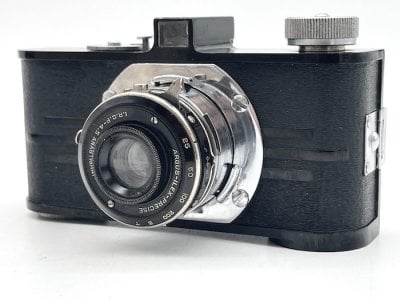
The Argus A: An attractive Art Deco bakelite body offset with well executed chrome trim, it was the first mass market 35 made in the U.S.A.
Why Bakelite? It’s cheap, it works, and Argus knew how to use it!
Bakelite, a combination of phenol and formaldehyde, was the first truly synthetic resin and represented a great advance over earlier plastics that were based on modified natural materials. Bakelite is dimensionally stable over a wide temperature range, easy to mold, cast, and machine, and is almost always dark colored and opaque, making it an excellent choice for camera bodies. It’s also cheap to produce and lends itself to a wide variety of complex shapes, such as Art Deco contours. On the down side, it lacks the flexibility and impact resistance if modern plastics and can shatter on severe impact. Moral: don’t drop your Argus A or C3 from great heights or hurl it to the sidewalk in a fit of pique-
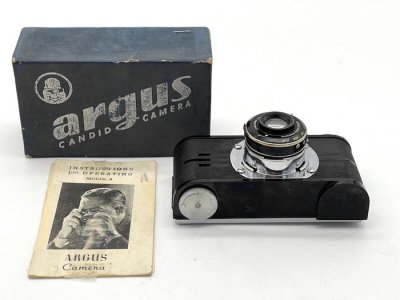
Argus A, shown here with original "Candid Camera" box and instruction manual sold for $12.50 in the '30s and was an instant sensation.
The Argus A is fitted with a collapsible 50mm f/4.5 I.R.C. Anastigmat lens, a decent but unspectacular Cooke triplet design with an 8-bladed diaphragm that sadly only stops down to f/11, and an Ilex Precise ever-set (no cocking required) leaf shutter with speeds of 1/25, 1/50, 1/100, and 1/200 sec plus T and B. I.R.C. stands for the International Research Corporation, then the official corporate name. The company, that eventually became Argus Cameras, Inc., was originally founded as the International Radio Corporation in 1931 by a group of local businessmen from Ann Arbor, Michigan who wanted to incentivize business opportunities in the area and create much-needed jobs during the Great Depression. The International Radio Corporation made and successfully marketed Bakelite-bodied Argus radios and held the patent on AC/DC radios which they later sold to RCA. But the Argus A camera was so successful I.R.C. sold the radio business, and the rest, as they say, is history. For more complete historical info on the redoubtable Argus A click on Argus A
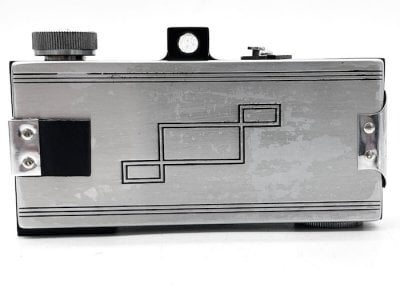
Back view of metal back of Argus A has Art Deco pattern in same style as body contours, Primitive back mounting catches are tricky--see text.
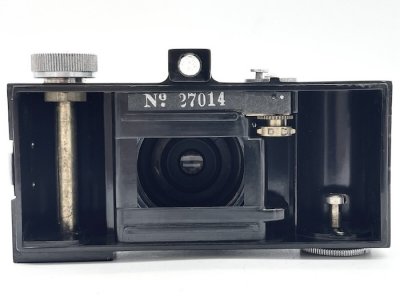
Spartan interior of Argus A shows film cartridge chamber (right) take-up spool (left) and single sprocket wheel to right of Bakelite guide rails.
The Argus A’s collapsible lens is mounted on a spring-loaded chrome tube with tabs on the end toward the body to hold it place in the collapsed position. Once you extend the lens you can select either of two focusing ranges by twisting the tube until it clicks in place in the “near” (more extended) or “far” (less extended) position. On early Argus A models, the ranges correspond to 6 ft. to 12 ft., and 12 ft. to infinity; on later models like the one used to shoot the pictures included here, the ranges are 6 ft to 18 ft. and 18 ft. to infinity. The latter version also has a metal tripod socket plate screwed into the bottom. Clearly close-ups are not the Argus A’s forte, but Argus did eventually offer the Argus AF of 1937-1938, and the Argus A2F of 1939-1941, each closely based on the Argus A but with a unit-focusing helical at the rear of the lens and a textured focusing ring that provided scale focusing capability down to 15 inches! The A2F also had a built-in extinction meter.
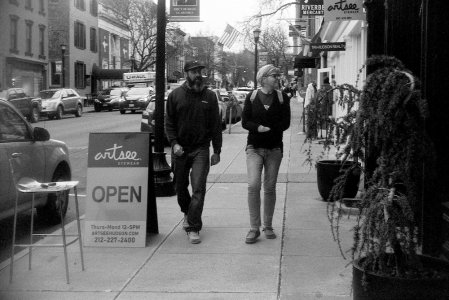
Strollers on Warren Street, Hudson, NY shot with Argus A. Handheld exposure: 1/200 sec at f/8 on Ilford HP-5 Plus.
The joys and frustrations of shooting with an Argus A
Loading the Argus A is straightforward thanks to its removable metal back that’s adorned with an attractive Art Deco design. According to the manual, you press in and hold the dimple on the chrome spring catch on the camera’s left side and then you should be able to pull the back off using a little leatherlike tab affixed to the back lock receptacle on the left-hand side of the back unit. This never worked on my Argus A so I pressed in the dimple as hard as I could while hooking a fingernail under the female (receiving) end of the catch and simply pulled the back off—inelegant and effective, but a little hard on the fingernail! The camera loads from right to left so you pull down the bottom mounted rewind knob all the way out to provide clearance for the film cartridge, insert the cartridge, and push the rewind knob back in, turning it as needed to get its prongs to seat within the bottom of the cartridge spool. Now thread the film leader into the very wide slot of the take-up spool and wind the film advance knob until the single sprocket wheel engages the film perforations and the film is running evenly onto the take-up spool. When the film lies flat across the film aperture and the sprocket wheel locks, preventing further advance, press in and hold the sprocket wheel release button behind the top mounted frame counter, start turning the film advance knob, then immediately remove your finger from the sprocket wheel release button, and continue winding until the film locks in place at the next frame. Now you’re ready to close the camera back and (manually) zero the additive frame counter. When reattaching the back, make doubly sure that the fixed catch on its right-hand side is properly seated across the mounting slot in the body, then press in the dimple on the male part of the catch, press firmly on the left-hand part of the back until it locks in place with an audible click, and verify that the back is lying evenly across the back with no gaps. Perhaps the most charitable description of the Argus A’s back lock is ‘crude but effective,” but if you make a mistake the result can be disastrous—don’t ask me how I know.
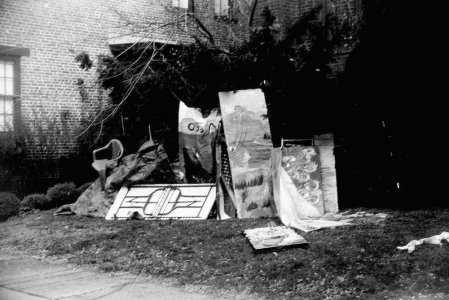
Homeless artist's encampment, Hudson, NY shot with Argus A. Tech data: f/5.6 at 1/100 sec on Ilford HP-5 Plus.
Since the Argus A (like the Argus C3, early Kodak Retinas, and even the Kodak Signet 35) is afflicted with the notorious “release the sprocket” system of film winding, the film wind and shutter cocking functions are totally separate (that is, uncoupled). It’s easy to shoot double exposures by mistake and even blank exposures are possible if you’ve forgotten whether you wound the film or not. The solution: always wind the film immediately after you’ve taken the shot, and don’t cock the shutter until you’re ready to take the next shot. On the Argus A, which doesn’t require shutter cocking, just make sure to wind the film immediately after you take a picture, and you should be OK. Once I got used to shooting with r=the Argus A, I found it t be a “fun vintage” experience and the only things I really missed were close focusing ability, and an f/16 or f/22 apertures, which would have given me enough depth of field to shoot sharp pictures of subjects at closer distances. Other gripes: turning the front-mounted shutter speed dial by pressing and turning the milled surface on the front of the ring is annoying and a pain in the fingers, and the tiny f/sop scale on the lens barrel is hard to read in low light. Surprisingly the little ditzy top mounted optical finder is excellent—better than the ones fitted to some elite 35s I’ve used.
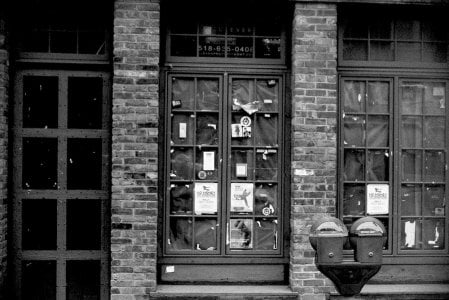
Windows, Hudson, NY shot with Argus A with 50mm f/4.5 I.R.C. lens, f/5.6 at 1/100 on Ilford HP-5 film.
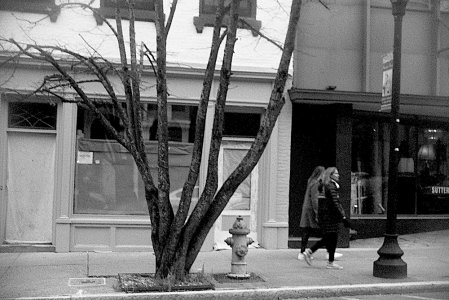
Street Scene, Hudson, NY shot with Argus A and 50mm f/4.5 I.R.C. lens, 1/100 sec at f/5.6 on Ilford HP-5 Plus film.
Perhaps the most remarkable things about the Argus A is that it sold for $12.50 back in the late ‘30s (sadly, equivalent to over $260 in 2023 dollars!), got more Americans into shooting 35mm than even the legendary Leica I (Model A), and paved the way for the immortal Argus C3, the “brick,” the best-selling American made 35mm rangefinder camera of all time at over 3 million copies. Perhaps even more amazing is that the marketing geniuses at Eastman Kodak didn’t see the potential of a 35mmn camera for the masses and get there first. My verdict: a well-made, attractive, and engaging camera that can deliver surprisingly good results, especially considering its modest specs. Indeed, I’m so inspired, I just bought an Argus AF with a fully focusing lens for a paltry 25 bucks, about what you can expect to pay for a clean functional Argus A, and I can’t wait to shoot some closeups with it.
The modest Art Deco cutie that put 35mm film on the map in the U.S.A.
By Jason Schneider
The humble Bakelite bodied Argus A was not, as some have claimed, the first American made 35mm still camera—it was preceded by the rare Missouri-made Smith of 1912, and the Simplex and Tourist Multiple, both introduced in 1914. However, this spartan Art Deco classic may well be the most important American 35mm camera because it was the first inexpensive U.S.-made 35 and was largely responsible for popularizing the 135 format (24 x 36mm) in the United States at a time when the country was still in the throes of the Great Depression.

The Argus A: An attractive Art Deco bakelite body offset with well executed chrome trim, it was the first mass market 35 made in the U.S.A.
Why Bakelite? It’s cheap, it works, and Argus knew how to use it!
Bakelite, a combination of phenol and formaldehyde, was the first truly synthetic resin and represented a great advance over earlier plastics that were based on modified natural materials. Bakelite is dimensionally stable over a wide temperature range, easy to mold, cast, and machine, and is almost always dark colored and opaque, making it an excellent choice for camera bodies. It’s also cheap to produce and lends itself to a wide variety of complex shapes, such as Art Deco contours. On the down side, it lacks the flexibility and impact resistance if modern plastics and can shatter on severe impact. Moral: don’t drop your Argus A or C3 from great heights or hurl it to the sidewalk in a fit of pique-

Argus A, shown here with original "Candid Camera" box and instruction manual sold for $12.50 in the '30s and was an instant sensation.
The Argus A is fitted with a collapsible 50mm f/4.5 I.R.C. Anastigmat lens, a decent but unspectacular Cooke triplet design with an 8-bladed diaphragm that sadly only stops down to f/11, and an Ilex Precise ever-set (no cocking required) leaf shutter with speeds of 1/25, 1/50, 1/100, and 1/200 sec plus T and B. I.R.C. stands for the International Research Corporation, then the official corporate name. The company, that eventually became Argus Cameras, Inc., was originally founded as the International Radio Corporation in 1931 by a group of local businessmen from Ann Arbor, Michigan who wanted to incentivize business opportunities in the area and create much-needed jobs during the Great Depression. The International Radio Corporation made and successfully marketed Bakelite-bodied Argus radios and held the patent on AC/DC radios which they later sold to RCA. But the Argus A camera was so successful I.R.C. sold the radio business, and the rest, as they say, is history. For more complete historical info on the redoubtable Argus A click on Argus A

Back view of metal back of Argus A has Art Deco pattern in same style as body contours, Primitive back mounting catches are tricky--see text.

Spartan interior of Argus A shows film cartridge chamber (right) take-up spool (left) and single sprocket wheel to right of Bakelite guide rails.
The Argus A’s collapsible lens is mounted on a spring-loaded chrome tube with tabs on the end toward the body to hold it place in the collapsed position. Once you extend the lens you can select either of two focusing ranges by twisting the tube until it clicks in place in the “near” (more extended) or “far” (less extended) position. On early Argus A models, the ranges correspond to 6 ft. to 12 ft., and 12 ft. to infinity; on later models like the one used to shoot the pictures included here, the ranges are 6 ft to 18 ft. and 18 ft. to infinity. The latter version also has a metal tripod socket plate screwed into the bottom. Clearly close-ups are not the Argus A’s forte, but Argus did eventually offer the Argus AF of 1937-1938, and the Argus A2F of 1939-1941, each closely based on the Argus A but with a unit-focusing helical at the rear of the lens and a textured focusing ring that provided scale focusing capability down to 15 inches! The A2F also had a built-in extinction meter.

Strollers on Warren Street, Hudson, NY shot with Argus A. Handheld exposure: 1/200 sec at f/8 on Ilford HP-5 Plus.
The joys and frustrations of shooting with an Argus A
Loading the Argus A is straightforward thanks to its removable metal back that’s adorned with an attractive Art Deco design. According to the manual, you press in and hold the dimple on the chrome spring catch on the camera’s left side and then you should be able to pull the back off using a little leatherlike tab affixed to the back lock receptacle on the left-hand side of the back unit. This never worked on my Argus A so I pressed in the dimple as hard as I could while hooking a fingernail under the female (receiving) end of the catch and simply pulled the back off—inelegant and effective, but a little hard on the fingernail! The camera loads from right to left so you pull down the bottom mounted rewind knob all the way out to provide clearance for the film cartridge, insert the cartridge, and push the rewind knob back in, turning it as needed to get its prongs to seat within the bottom of the cartridge spool. Now thread the film leader into the very wide slot of the take-up spool and wind the film advance knob until the single sprocket wheel engages the film perforations and the film is running evenly onto the take-up spool. When the film lies flat across the film aperture and the sprocket wheel locks, preventing further advance, press in and hold the sprocket wheel release button behind the top mounted frame counter, start turning the film advance knob, then immediately remove your finger from the sprocket wheel release button, and continue winding until the film locks in place at the next frame. Now you’re ready to close the camera back and (manually) zero the additive frame counter. When reattaching the back, make doubly sure that the fixed catch on its right-hand side is properly seated across the mounting slot in the body, then press in the dimple on the male part of the catch, press firmly on the left-hand part of the back until it locks in place with an audible click, and verify that the back is lying evenly across the back with no gaps. Perhaps the most charitable description of the Argus A’s back lock is ‘crude but effective,” but if you make a mistake the result can be disastrous—don’t ask me how I know.

Homeless artist's encampment, Hudson, NY shot with Argus A. Tech data: f/5.6 at 1/100 sec on Ilford HP-5 Plus.
Since the Argus A (like the Argus C3, early Kodak Retinas, and even the Kodak Signet 35) is afflicted with the notorious “release the sprocket” system of film winding, the film wind and shutter cocking functions are totally separate (that is, uncoupled). It’s easy to shoot double exposures by mistake and even blank exposures are possible if you’ve forgotten whether you wound the film or not. The solution: always wind the film immediately after you’ve taken the shot, and don’t cock the shutter until you’re ready to take the next shot. On the Argus A, which doesn’t require shutter cocking, just make sure to wind the film immediately after you take a picture, and you should be OK. Once I got used to shooting with r=the Argus A, I found it t be a “fun vintage” experience and the only things I really missed were close focusing ability, and an f/16 or f/22 apertures, which would have given me enough depth of field to shoot sharp pictures of subjects at closer distances. Other gripes: turning the front-mounted shutter speed dial by pressing and turning the milled surface on the front of the ring is annoying and a pain in the fingers, and the tiny f/sop scale on the lens barrel is hard to read in low light. Surprisingly the little ditzy top mounted optical finder is excellent—better than the ones fitted to some elite 35s I’ve used.

Windows, Hudson, NY shot with Argus A with 50mm f/4.5 I.R.C. lens, f/5.6 at 1/100 on Ilford HP-5 film.

Street Scene, Hudson, NY shot with Argus A and 50mm f/4.5 I.R.C. lens, 1/100 sec at f/5.6 on Ilford HP-5 Plus film.
Perhaps the most remarkable things about the Argus A is that it sold for $12.50 back in the late ‘30s (sadly, equivalent to over $260 in 2023 dollars!), got more Americans into shooting 35mm than even the legendary Leica I (Model A), and paved the way for the immortal Argus C3, the “brick,” the best-selling American made 35mm rangefinder camera of all time at over 3 million copies. Perhaps even more amazing is that the marketing geniuses at Eastman Kodak didn’t see the potential of a 35mmn camera for the masses and get there first. My verdict: a well-made, attractive, and engaging camera that can deliver surprisingly good results, especially considering its modest specs. Indeed, I’m so inspired, I just bought an Argus AF with a fully focusing lens for a paltry 25 bucks, about what you can expect to pay for a clean functional Argus A, and I can’t wait to shoot some closeups with it.
Last edited:
ranger9
Well-known
You had me at the first sentence: If the "Missouri-made Smith" is rare relative to the sparse Simplex, it must be (as we Missouri natives might say) gol-dang rare. Hope to hear more about this someday...
raydm6
Yay! Cameras! 🙈🙉🙊┌( ಠ_ಠ)┘ [◉"]
Interesting! I never heard of this early 35mm camera either. I found this reference to it:You had me at the first sentence: If the "Missouri-made Smith" is rare relative to the sparse Simplex, it must be (as we Missouri natives might say) gol-dang rare. Hope to hear more about this someday...

former of the herd
Newbie
Who knew? I had to look it up. Richmond Heights is a suburb of St. Louis. I'm originally from the north western part of the state and just considered St. Louis an old dirty river town.You had me at the first sentence: If the "Missouri-made Smith" is rare relative to the sparse Simplex, it must be (as we Missouri natives might say) gol-dang rare. Hope to hear more about this someday...
Jason,
The Argus A also helped establish the collectible special edition 35,
with Argus A special edition colors of gold, white, olive green, and gray.
Any information on their production?
Gold version covered here Argus A Gold designed by brothers Art and Fred Deco.
The Argus A also helped establish the collectible special edition 35,
with Argus A special edition colors of gold, white, olive green, and gray.
Any information on their production?
Gold version covered here Argus A Gold designed by brothers Art and Fred Deco.
Share:

